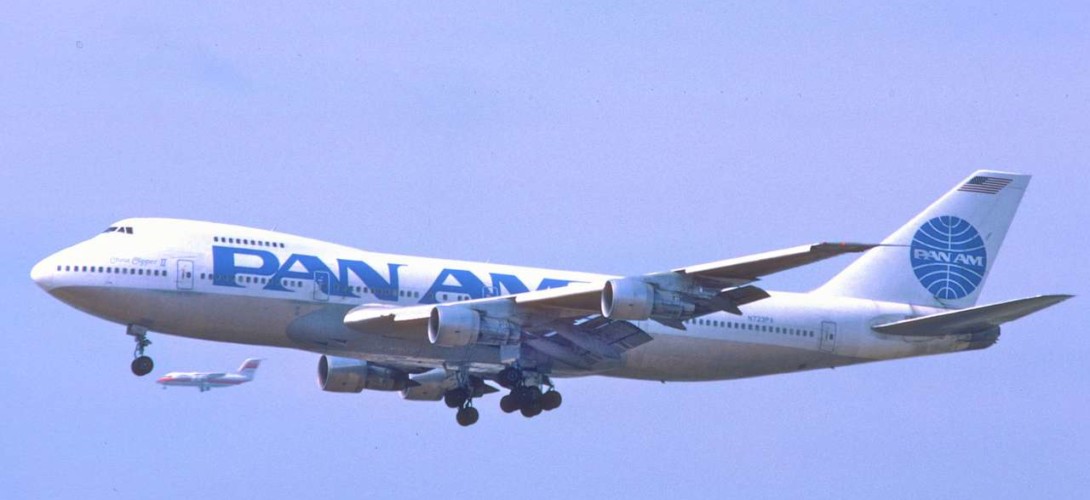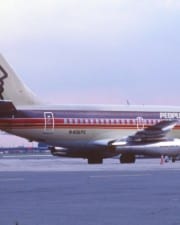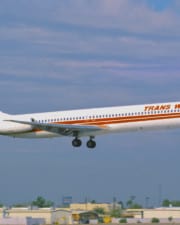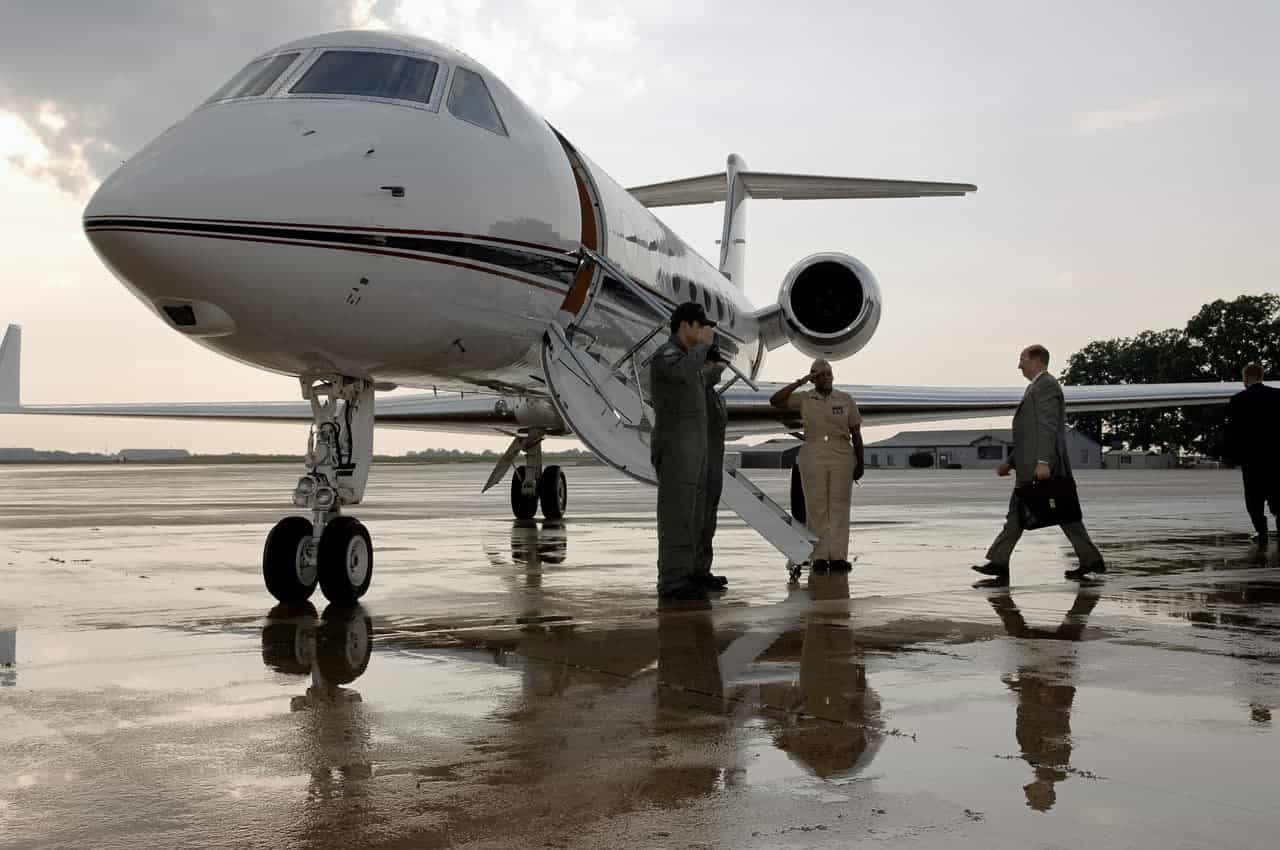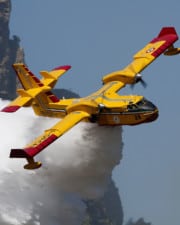Once upon a time there was an airline that was among America’s most affordable and iconic, that began as an air mail service and grew to service international flights, and then, poof! It was gone. This’s Pan Am Airlines’ story.
In a way, Pan Am’s antiquity makes its story that much more compelling. In life, they were a leading airline at times, sure, but “just” an airline.
But just as the Brooklyn Dodgers call to mind the ‘40s and ‘50s and the Beatles instantly signify the ‘60s, Pan Am’s defunct status recalls a bygone middle- to upper-class jet-setting era.
This is when international travel was just beginning to become affordable to businesspeople and then to the masses, and Pan Am was at the center of it all.
So what happened to Pan Am?
1. In the Beginning

Pan Am rose from humble origins but its international bent was already obvious. It was founded in 1927 as an air mail delivery company and conducted the first regularly scheduled international flight, delivering mail internationally.
Pan Am achieved its first success delivering mail internationally between Florida and Havana. Throughout the ‘30s it expanded its operations to cover more routes both internationally and in the United States.
Hence the “Pan American” name, which is the answer to the inevitable question “what does Pan Am mean?”
By the late ‘40s it helped pioneer tourist fares, making airline travel more affordable and accessible to far more people than had ever imagined.
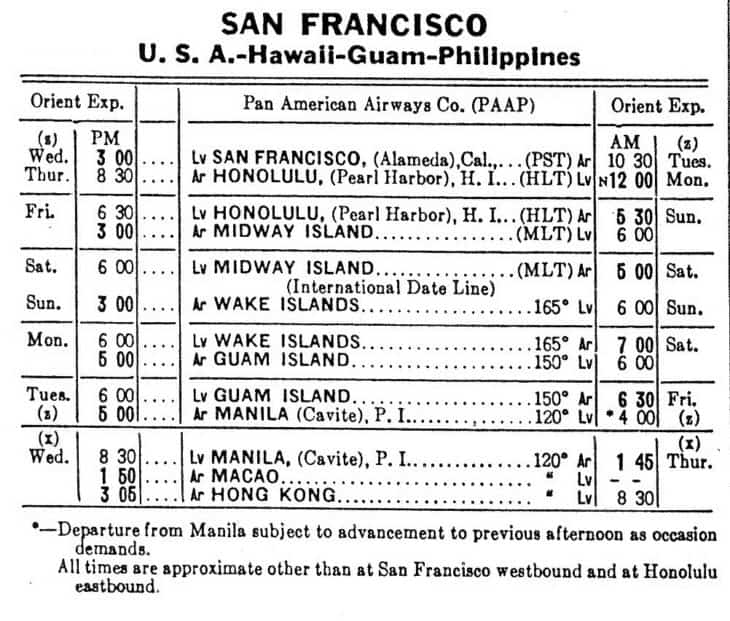
Throughout the Second World War, men and women on the front and at home had fought to free the world of fascism and racism. Now, with affordable tourist fares such as Pan Am’s, some of those same men and women could travel the world more freely than ever before.
2. The ‘50s and the Golden Age
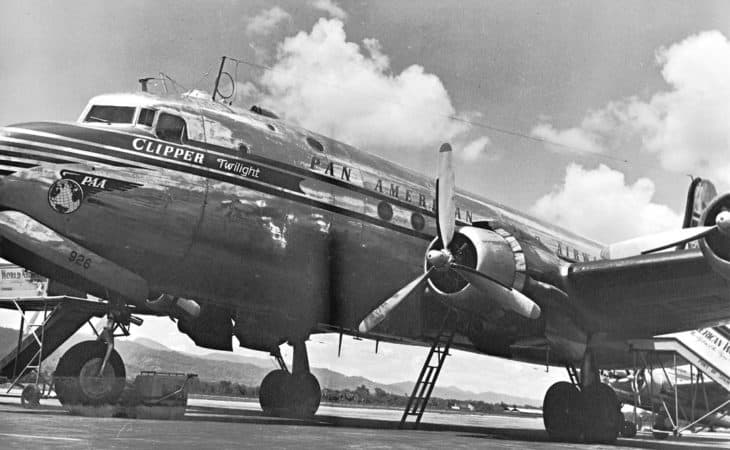
By the ‘50s, Pan Am was one of the biggest names of the industry. Throughout the late ‘50s and into the ‘60s, it marketed its airline as luxury in particular.
Marketing ads from these times played up Pan Am’s many luxurious innovations, from better airline food to more comfortable seats and, when it finally arrived, jet travel.
Despite the sexism rampant in the employee/employer relationship coloring stewardess work at the time, the Pan Am Historical Foundation boasts that Pan Am stewardesses were chosen specifically for their “sophisticated and well-educated” nature.
3. The ‘60s, Beatlemania, and the Boeing 707
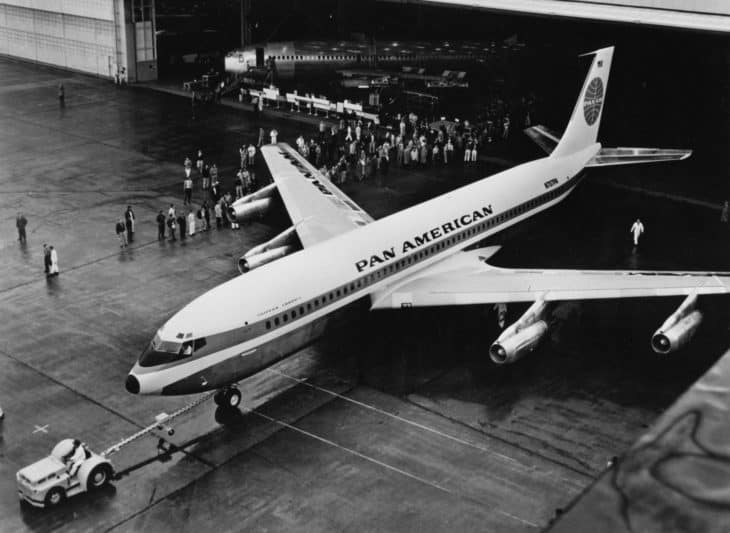
While they “Flew in from Miami Beach” before arriving “Back in the USSR” a few years later (in song form, anyway), the Beatles actually took a Pan Am flight a few years before they wrote that song.
On February 7th, 1964, cultural history was made when John, Paul, George, and Ringo touched down stateside. Two days later, they gave their famous performance on the Ed Sullivan Show. They toured the states for three weeks before returning to the UK on February 22nd, again flying Pan Am.
For aviation fanatics, the flight there and back was done with a Boeing 707-331. It is nearly 152ft long, with a wingspan of nearly 146ft, with a top vertical fin nearly 42.5ft tall, and a weight of 146,400lbs.
It was powered by four Pratt & Whitney JT3D-3 turbofan engines, each of which could produce 18,000lbs of thrust, for a maximum speed of 552mph.
This was the beginning of Beatlemania, the British Invasion, and an age of rebellion. It was also the beginning of the end for old-fashioned airlines, The Jet Set, and the age of Pan Am.
4. The ‘70s and Problems Begin

Why did Pan Am fail? There’s no one reason but as we’ll see, many mounting issues.
By the dawn of the ‘70s, Pan Am was already facing problems. It faced increasing competition. Its image of classic ‘50s and ‘60s jet-setting luxury looked antiquated by the dawn of the new decade.
They tried to keep up, inaugurating the age of in-flight movies in 1965 and advertising itself through the late ‘60s and early ‘70s as the “World’s Most Experienced Airline.”
However, with jet travel cheaper and more common, their once-special offers now seemed blasé. And then the Oil Problems began.
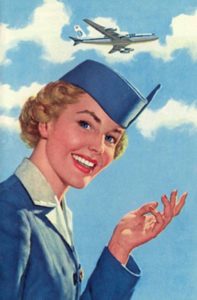
In 1973, the Yom Kippur War broke out when several Arab states attacked Israel along the Sinai Peninsula on the holiest day of the Hebrew calendar. In 1979, the Iranian Revolution began. The United States supported Israel following the former attack and broadly opposed the latter.
But the politics of these era-defining world-changing conflicts aside, Arab states placed oil embargoes on US companies. As a result, huge oil shortages hurt companies that depended on them the most — like, say, airlines.
Even worse, the mid to late-’70s saw energy shortages, outsourced jobs, stagnation, and inflation in the United States and especially in European countries such as the United Kingdom. As a result, Americans and many Europeans took fewer vacations hurting industries that depended on travel and tourism — again, like airlines.
This confluence of considerations were hugely concerning to Pan Am. While oil shortages were obviously of great concern to the entire industry, it was especially concerning to Pan Am given the fact they were already losing ground to the new top-tier airlines.
These problems became even bigger with the Airline Deregulation Act passed by Congress in 1978. Prior to 1978, the US regulated airline prices. However, in 1978, despite bipartisanship already becoming rarer in Washington, a bipartisan vote of Democrats and Republicans came together to deregulate the industry, allowing airlines to make pricing more competitive.
However, “more competition” was the last thing that Pan Am needed. To stay afloat, Pan Am sold off the rights to its Pacific routes to United Airlines for a much-needed infusion of $750 million, deciding to focus instead on transatlantic flights. Still, it was another sign of how the once-mighty had fallen.
They had lost their once-golden image of luxury and prestige, they had lost ground to other better-equipped competitors, and in the 1980s, Pan Am would lose more than anyone could ever imagine.
5. 1985: The Mechanic Strike

The mid-’80s were a time of economic volatility. For some, it was a capitalist free for all of Gordon Gekko and “Greed is Good!” For others, however, it was a period of reduced wages and labor strife.
The Reagan Administration was heavy on deregulation and vesting more power in corporations at the cost of unions. This profited some, hurt others, and this clash inevitably led to strikes. Pan Am was not immune.
The Pan Am Mechanic Strike of 1985 came at a vulnerable time for the company. As The Los Angeles Times reported on February 28th, the day the strike began, Pan Am had “not made a profit since 1980” and had “cut more than 8000 jobs in the last five years.”
To get a full idea of how badly Pan Am was bleeding cash at that point, it had cut $106.7 million in 1984.
In fairness, Pan Am’s mechanics were worse paid than others at other airlines. As per that Los Angeles Times report, the “top base salary” for Pan Am mechanics was about $29,500 (roughly equivalent to $70,200 in 2020.)
When “compared with $39,600 at United Airlines” for their mechanics’ salary, two things become clear.
First, Pan Am mechanics’ grievances were substantial and understandable. Secondly, however, that price disparity also suggests that Pan Am possibly couldn’t afford to pay as much as competitors, hinting at just how far they lagged behind their biggest competitors.
6. 1986 to 1988: Meltdowns, Terrorism, and Trouble Abroad

As if things couldn’t get any worse, the Chernobyl nuclear disaster happened in 1986. Of course, to put things in the proper context, economic concerns pale in comparison to the horrific loss of human life and still-massive environmental catastrophes.
Even so, Pan Am was experiencing a meltdown of a different yet related kind. This had happened just after they decided to focus on transatlantic flights to Europe, after all. Now, a major European market was “radioactive,” literally and economically.
Suddenly, people were wary of traveling to not just the Chernobyl area but much of Eastern Europe.
And that wasn’t even the only international disaster to befall Pan Am in 1986.
On September 5th 1986, Pan Am 73 took off from Mumbai bound for New York with scheduled layovers in Karāchi and Frankfurt. When the Karāchi layover took place, the plane was hijacked by the Abū Niḍāl Organization, a Palestinian-affiliated terrorist organization.
The ensuing standoff lasted 16 hours. Pakistani authorities eventually apprehended and imprisoned the hijackers but not before 22 hostages were killed and 150 injured.
Pan Am 73 has gone down in history as one of the most infamous airline disasters in history. For the company, it was a powerful and tragic exception to the maxim “Any Press is Good Press.”
While it wasn’t Pan Am’s fault, having the Pan Am name and brand “associated” with the hijacking toxified their reputation even further, which was not a great sign for a company that was already struggling post-mechanic strike and Chernobyl. By every measure, Pan Am was in dire straits by this time.
And the ‘80s, and their terrorism problems, weren’t event through yet. In 1988, yet another Pan Am flight would go down in history for all the wrong reasons.
On December 21st 1988, Pan Am 103 departing from London to New York exploded over the skies of Scotland.
As with Pan Am 73, terrorism was the culprit. A bomb was hidden inside a cassette player. All 243 passengers and 16 crew members were killed as well as 16 people on the ground in Lockerbie.
Once again, it wasn’t really Pan Am’s fault.
But once again, it stained Pan Am’s name in the eyes of consumers. With more and better-funded competitors, massive financial problems, and these unfortunate tragedies to their name, Pan Am was on the brink and the ‘90s would push them over.
7. 1991: The Gulf War and the End of Pan Am
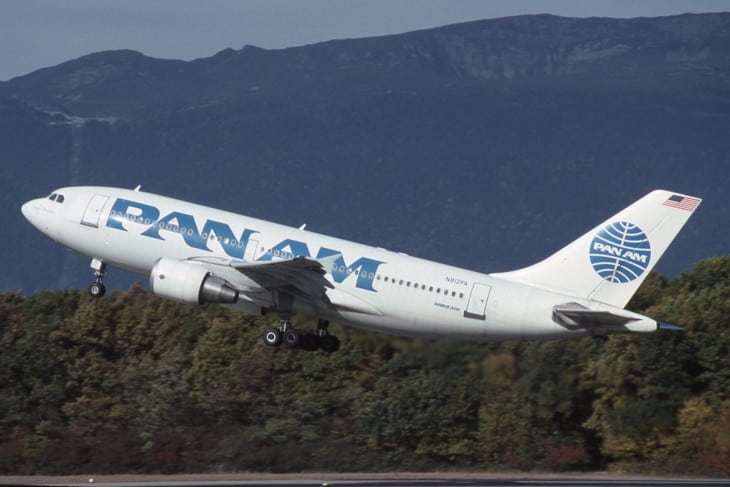
Another decade, another American war in the desert, and another oil shortage. The Gulf War was comparatively short and seen as successful by many but for industries dependent on oil, it was another gut check and, for Pan Am, a body blow.
Whether or not Pan Am could have survived without the increased pressure of this mini oil crisis, it was too much for the company as it was.
As 1990 turned into early 1991, the signs that the end was nigh were everywhere. Pan Am was hemorrhaging money, its reputation had never recovered from the horrific terrorist attacks, and a company that had once been on the cutting edge of comfort in the air was now woefully behind.
By this point, competitors had largely taken over what was left of Pan Am’s original pathways, including those to Europe. There was no saving the company and the death throes were near their end.
The airline had once brought the Beatles to America, but by now, that “Yesterday” seemed so far away and by December, you couldn’t buy a “Ticket to Ride” or find yourself “Back in the USSR.” Both Pan Am and the USSR dissolved within weeks of each other in December 1991.
If you’re wondering when did Pan Am stop flying, and when did Pan Am go out of business, that would be on December 4th 1991, as the “World’s Most Experienced Airline” made its last flight from Bridgetown in Barbados to Miami.
If you’re wondering who bought Pan Am, it was Delta. Even so, what profited Delta did not necessarily help those left in the lurch by Pan Am’s demise. In the aftermath of Pan Am’s end, more than 7500 people were laid off while the fleet was liquidated.
Pan Am’s ghost would linger on a bit longer, haunting the airline industry like Hamlet’s father, a specter of what was, but extremely short-lived revival attempts in 1996 and 1998 fizzled out quickly.
As for the airline that bought Pan Am’s Pacific routes (United) and the remnants of the company (Delta), they’re both obviously still around. While Pan Am’s marketing focused so heavily on quality and luxury, however, those two airlines have taken radically different routes in that regard. A 2019 Wall Street Journal ranking of US airline quality put Delta first, with United tied for second-last.
References ▾
- https://www.deltamuseum.org/exhibits/delta-history/family-tree/pan-am
- https://www.investopedia.com/financial-edge/0610/dead-airlines-and-what-killed-them.aspx
- https://www.history.com/this-day-in-history/pan-am-flight-103-explodes-over-scotland
- https://www.in2013dollars.com/us/inflation/1985?amount=29500
- https://www.latimes.com/archives/la-xpm-1985-02-28-mn-12744-story.html
- https://www.govtrack.us/congress/bills/95/s2493
- https://www.britannica.com/event/Pan-Am-flight-73-hijacking
- https://www.panam.org/pan-am-stories/551-luxury-on-wings
- https://www.aerotime.aero/yulius.yoma/17002-history-hour-pan-america-flew-the-beatles-for-us-first-visit
Related Posts
